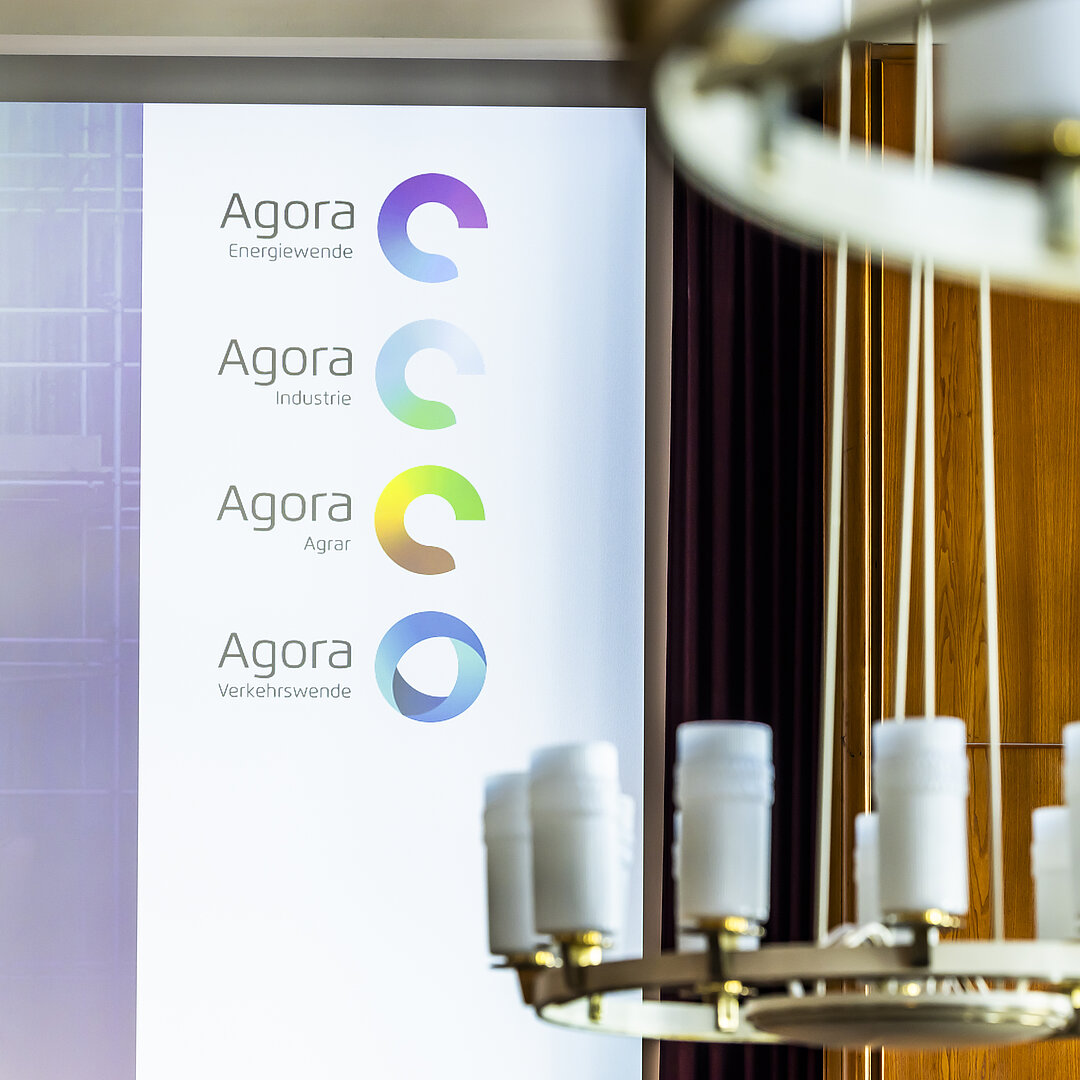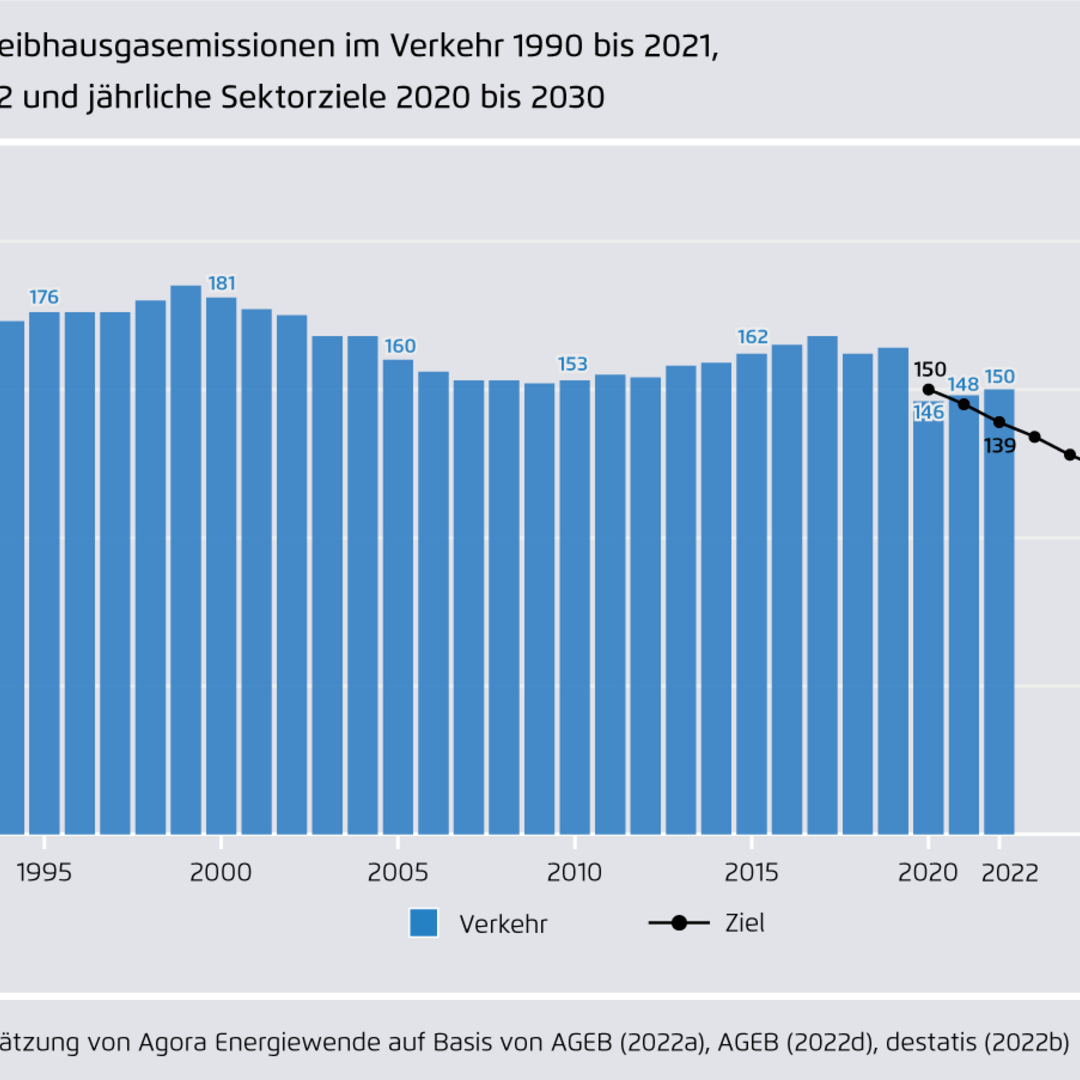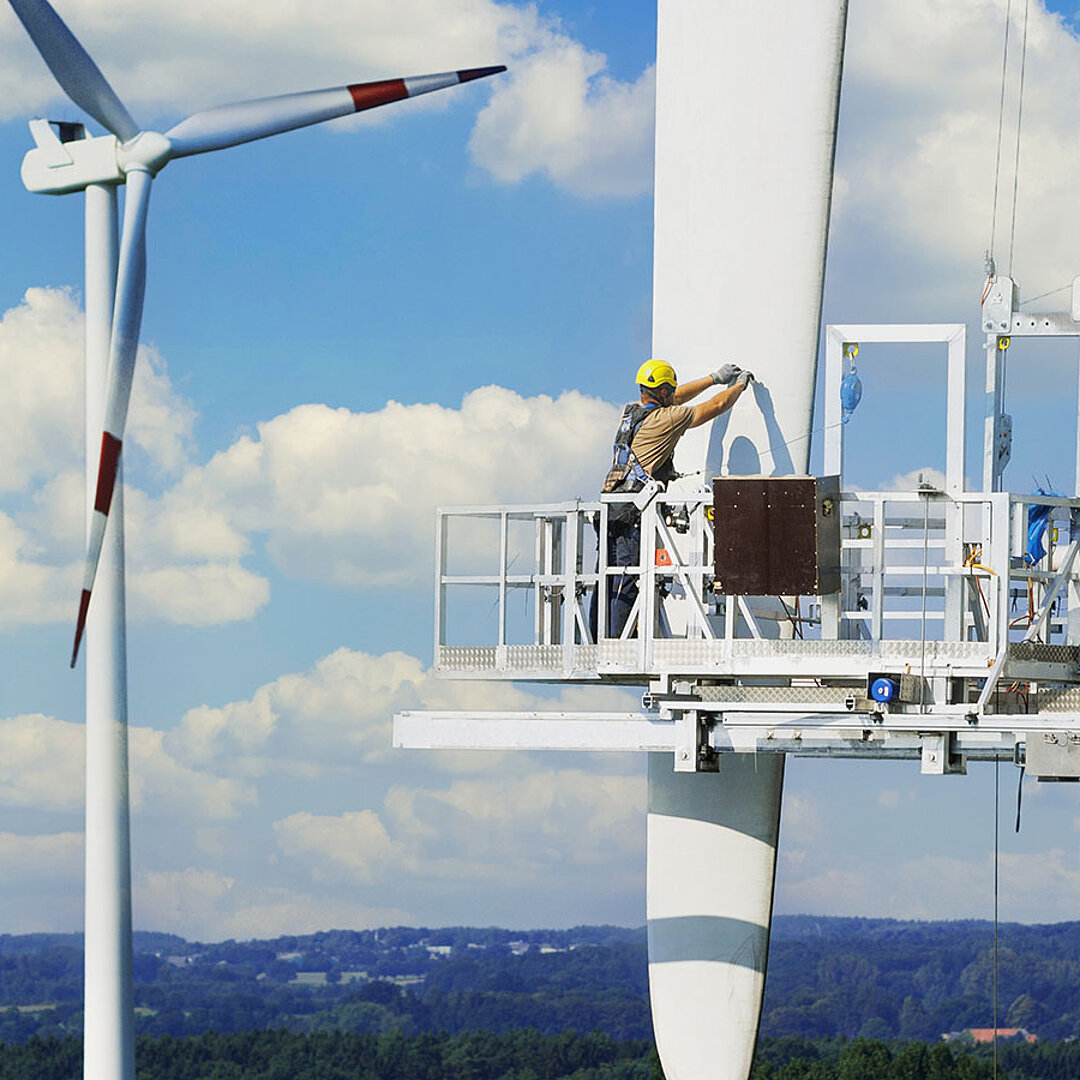- Autor:innen
- Johanna Wietschel, Carl-Friedrich Elmer, Marion Vieweg, Dr. Wiebke Zimmer, Janna Aljets, Wolfgang Aichinger, Philine Gaffron, Philipp Kosok, Elisabeth le Claire, Dr. Urs Maier, Kerstin Meyer, Fanny Tausendteufel, Christian Hochfeld, Johannes Oetjen, Naville Geiriseb, Leon Berks, Ulf Neuling
- Publikationsnummer
- 120-2025-EN
- Versionsnummer
- 1.0
- Veröffentlichungsdatum
-
5. Dezember 2024
- Seitenzahl
- 40
- Zitiervorschlag
- Agora Verkehrswende (2024): From progress in fragments to a joint venture as a whole. Assessment of climate policy in transport in Germany at the end of the traffic light coalition with recommendations for a course towards climate neutrality, competitiveness and social justice.
- Projekt
- Diese Publikation wurde erstellt im Rahmen des Projektes Klimaneutrales Deutschland 2045.
Dieser Inhalt ist auch verfügbar auf: Englisch
From progress in fragments to a joint venture as a whole
Assessment of climate policy in transport in Germany at the end of the traffic light coalition with recommendations for a course towards climate neutrality, competitiveness and social justice

- Description
- Conclusion: Progress in fragments
- Outlook: Five priorities for the next legislative period
- 1 | Fair prices in road transport
- 2 | Public interest in urban transport
- 3 | More services for rural areas
- 4 | Offensive for local public transport
- 5 | Doubling of rail passenger numbers
- 6.1 | Rapid ramp-up of electromobility
- 6.2 | Targeted utilisation of climate-neutral fuels
- 7 | Bolstering rail and electrification of road freight transport
- 8 | Sustainable transport infrastructure planning and financing
- 9 | Structural change in industry and regions
- 10.1 | Transport transformation as a joint venture: new alliances
- 10.2 | Transport transformation as a joint venture: municipalities
- 10.3 | Transport transformation as a joint venture: international cooperation
Description
With this publication, Agora Verkehrswende is drawing up a preliminary final assessment of climate policy in transport at the end of the governing coalition of the SPD, Greens and FDP and three years after the “traffic light coalition” took office on December 8th, 2021.
In September 2021, shortly ahead of the Bundestag elections, Agora Verkehrswende had already presented an extensive overview of the instruments and measures that a federal government can use in the new legislative period to keep the climate protection targets for transport for 2030 on the path to climate neutrality within reach in the publication Vier Jahre für die Fairkehrswende (Four Years for the Fair Transport Transformation). This went hand in hand with a plea to jointly draw up a "Charter for a Fair Transport Transformation" right at the outset of the term of office, serving as a map and compass for government action on a socially just climate policy in transport and consequently also providing orientation and reliability for politics, business and society.
The instruments and measures that were suggested at the time served as a benchmark for Agora Verkehrswende a year later in the publication Vom rasenden Stillstand zum versprochenen Fortschritt? (From a frantic standstill to the promised progress?) in order to assess the federal government's climate policy for transport. The one-year interim assessment in December 2022 turned out to be sobering due to the fact that the parties of the self-proclaimed progressive coalition had so far failed to bring together their core values such as social justice, economic efficiency and freedom in a joint action plan for climate protection in the transport sector. The target laid down in the Climate Protection Act to cut greenhouse gas emissions from transport by around half by 2030 in comparison to 1990 had fallen further into the distance. Targeted plans set out in the coalition agreement, such as the speedy transition to electromobility, greater promotion of rail and public transport as well as the comprehensive reform of road traffic law, lacked sufficient backing with measures at the time. The structural inequality caused by obsolete subsidies and privileges for motorised private transport remained largely untouched. Greenhouse gas emissions generated by the German transport sector remained virtually unabated, with the exception of one-off effects caused by the coronavirus pandemic. The first twelve months of the traffic light coalition were therefore a lost year for climate protection in the transport sector, a year characterised by a frantic standstill.
The impression of insufficient progress has become even stronger two years later, in December 2024, because at the end of 2022 some projects had still given hope for improvement, as only part of the term of office had elapsed. The same criteria were again applied for this final review and the assessments were updated. Ultimately, the assessment reveals that what has been achieved neither fulfils what was announced in the coalition agreement nor the climate targets originally set. It is not the intentions in the coalition agreement that serve as the decisive yardstick, however, but rather all instruments and measures needed to get on track with climate protection in the transport sector by 2030. In other words, what is measured is not the distance to what has been politically agreed, but to what is necessary. This also makes it easier to identify where action needs to be taken when looking ahead. The primary objective is therefore to analyse the current status to obtain indications for shaping the future.
Conclusion: Progress in fragments
The reform of road traffic law is most likely one of the greatest successes of the traffic light coalition in terms of the transport transformation - in spite of the fact that an administrative regulation specifying the requirements of the StVO and giving municipalities more legal certainty is still pending. In other respects, progress has been made in freight transport above all - through the introduction of a CO₂ component in the HGV toll, the use of half of the revenue for the rail network and the initiatives for developing the charging infrastructure for battery-powered HGVs. The Deutschlandticket might have been a success story if it had been linked to an offensive aimed at expanding public transport. It has, after all, greatly simplified nationwide access and drawn more attention to public transport.
Given the challenge of making the transport sector climate-neutral by 2045, however, such isolated advances can only be seen as fragments of a transport transformation. For all its activity and endeavours, the traffic light coalition lacked a common comprehensive vision as a foundation for conceiving an effective bundle of tools, especially in the areas central to climate protection in the transportsector. Central political tools were either inadequately deployed or not addressed at all. This is why the transport sector is not on track when it comes to climate, industrial or social policy. Germany is in need of a clear strategy and decisive joint action in federal politics if it is to change this. The transport transformation will succeed as a joint endeavour - or else not.
Outlook: Five priorities for the next legislative period
The initiatives that the parties should consider with one eye towards the next legislative period for climate neutrality, competitiveness and social justice in transport can be categorised into five key areas:
Financial reform and investment offensive boost prosperity and social justice
Germany can achieve climate neutrality in the transport sector by 2045 - without compromising on mobility and without additional costs in comparison to what would have to be spent by 2045 without a course towards climate neutrality. Political hesitation will either drive up expenditure or greenhouse gas emissions, along with all the associated risks. Increased investment in the future is needed very soon, but not more money overall in the long term. More political will is needed above all to make future investments possible.
The federal government is developing a reliable strategy in line with the constitution and a financial architecture to establish the necessary infrastructure and public transport capacities, with which public investment can be secured quickly, over the long term and to a sufficient extent. For private investment - primarily in vehicles that are more climate-friendly and their energy supply - households and companies need framework conditions that are geared towards climate protection and guarantee planning security. A timely reform of taxes, levies and subsidies in relation to cars based on CO₂ emissions is of central importance - from vehicle and company car taxation to a CO₂ price combined with climate reimbursement and a polluter-pays car toll. This would allow the opportunities and burdens of the transformation to be shared more fairly than they are today.
Industrial transformation secures competitiveness and employment
If Germany is to remain a successful business location over the long term, industry must be determined to forge ahead with the transformation to climate neutrality that has already begun. The opportunities for the automotive industry are maximised by a rapid ramp-up of electromobility. This requires orientation and predictability as well as a strong domestic market for electric vehicles. That's why a stronger link between industrial and climate policy is needed at both European and national level over the coming years.
The foundation for this will remain ambitious CO₂ fleet limits, which will have to be flanked politically - with tools for ramping up electromobility in commercial fleets; with economic incentives aimed at making smaller electric cars in particular more affordable; on top of this, with a continued rapid expansion of the charging infrastructure. A bundle of tools that reduces fossil fuel subsidies and offsets the costs that combustion engine vehicles cause for the economy is particularly effective. The federal government can lobby at EU level for more investment in the battery value chain and for the establishment of Chinese battery and vehicle manufacturers based on common rules for the European market in preparation for the Clean Industrial Deal for the automotive industry.
The automotive value chains must also be rendered climate-neutral by the middle of this century. International harmonisation and further development of the methods for calculating CO₂ emissions along the value chain is essential if climate protection is to become a hard economic factor - for example in battery production or in the extraction and processing of raw materials. Vehicles and their components are ultimately going to be almost completely recyclable in line with the circular car vision and will be produced using secondary raw materials to the greatest extent possible. In order to achieve this, the federal government is pursuing a trade policy aimed at accelerating the fair global market ramp-up of electromobility and not slowing it down through barriers.
Integration of electromobility into the power grids reduces costs, accelerates the expansion of renewable power generation and boosts the ramp-up of e-cars
The industrial transformation and the ramp-up of electromobility mean that the transport and electricity sectors are increasingly converging. The electricity sector supplies the renewable electricity to reduce emissions in the transport sector; the transport sector offers the electricity sector additional flexibility, e.g. through the targeted management of charging processes and by supplying electricity stored in vehicle batteries to the grid.
The possibility of charging bidirectionally - from the grid to the battery and from the battery to the grid - harbours significant potential for reducing costs for both the energy and the transport transformation. Effective management of charging requirements helps to cover energy demand more efficiently while simultaneously increasing the utilisation of the electricity grid. In turn, these cost savings in the electricity grid can be used to reduce the charging costs of electromobility for users and thereby support the switch to electric cars. The federal government is shaping the framework conditions based on a clear target picture and implementing them accordingly in order to tap into this potential.
Climate-neutral fuels mark the end of the fossil fuel era
Climate-neutral fuels represent an important addition to climate protection in transport where there is no battery-electric solution - in particular in air and sea transport. Biofuels will only be available to a limited extent, however, because the ones that are conventionally obtained from energy crops compete with food and animal feed production when it comes to utilisation; and because the so-called advanced ones from residual and waste materials do not have a flexibly expandable raw material base.
When it comes to green hydrogen and climate-neutral synthetic fuels – also known as e-fuels, made using renewable electricity and CO₂ extracted from the atmosphere - it is technically feasible to produce much larger quantities. They are crucial for fulfilling various regulatory requirements within the framework of European climate policy. Nonetheless, e-fuels remain less energy-efficient and will in all probability only become available in very limited quantities and be expensive over the coming decades. They must therefore be produced and utilised systematically.
The industrial market ramp-up for the production of such fuels has stagnated substantially to date. There needs to be a long-term, inter-modal and cross-sectoral political concept in place that guarantees planning security beyond 2030 and develops further incentives and mechanisms to particularly realise the first production facilities. Only in this way can learning effects and cost reductions be achieved with a view to making e-fuels competitive. A committed approach from policymakers can ensure that Germany takes on a pioneering role and becomes a technology leader, helping to shape the global production of electricity-based climate-neutral fuels.
Affordable mobility for all ensures the same level of social participation in urban and rural areas
The prices of petrol and diesel will continue to escalate in line with the economic costs of burning fossil fuels. A significant price increase is expected in 2027 when European emissions trading is rolled out to the buildings and transport sectors. This is why an overall strategy is needed all the more to ensure that people on low to medium incomes in particular, who previously had to rely on their own vehicle with an internal combustion engine, are able to switch to climate-neutral alternatives - whether it's affordable electric vehicles or an attractive combination of buses and trains, flexible sharing or shuttle services and bikes.
Around 20 million people in Germany, most of whom live in rural areas, do not currently have a suitable public transport service on their doorstep and consequently are unable to benefit from the Deutschlandticket. What is needed here are better regional rail transport services or fast scheduled buses on busy routes, as well as feeder services and last-mile public transport with flexible on-demand vehicles. This will only be possible on a larger scale with automated vehicles in the medium term owing to staff shortages and labour costs. The support of autonomous driving, especially with regard to public and freight transport, is extremely important for Germany in terms of both industrial and transport policy. The paramount goal is a mobility guarantee ensuring a minimum public transport service across the country as a public service and consequently facilitating social participation. Private cars will continue to play an important role in regions with low population density, but with electric drive systems. The conditions for electric cars and charging infrastructure in combination with decentralised generation of wind and solar power are particularly favourable in rural areas. A new initiative for electromobility in rural areas can also contribute to making life there more attractive. Urban transport involves enabling clean and safe mobility for everyone and making valuable public space attractive for urban society by distributing it efficiently and fairly between modes of transport.
1 | Fair prices in road transport
Status
There has been little change to the fiscal framework conditions. Of note are the inclusion of climate damage costs in the HGV toll and its expansion to more vehicles. Purchase subsidies for electric cars were scrapped at the end of 2023. The car label now provides better information about CO₂ emissions and costs. The CO₂ price is back on the path originally agreed after a planned increase was temporarily suspended. The national CO₂ price will be replaced by EU-wide emissions trading (ETS2) in 2027. The accompanying climate social fund is intended to facilitate the transition to climate-friendly technologies and short-term compensation payments for groups that are particularly affected. Vehicle tax remains largely unchanged, with the exception of privileges for electric company cars being extended to higher-priced models; the planned relief for e-fuel-only vehicles is unlikely to be realised. A car toll designed to charge the costs for infrastructure and environment in line with the polluter-pays principle is not in sight.
Assessment
The path pursued with the fiscal tools does not pave the way to a climate-neutral future, especially as far as cars are concerned. The overall fiscal architecture also remains socially unbalanced. The federal government is not sufficiently supporting the necessary electrification of the car fleet, mainly through tax privileges such as company car taxation, which mainly benefit high-income households. The abrupt abolition of the purchase premium for electric cars as well as public discussions about the fleet limits that have already been decided are causing uncertainty among the population and industry and slowing down electrification. This makes the lack of effective vehicle taxation for cars with high CO₂ emissions all the more serious. There has been no progress towards reducing climate-damaging subsidies. Developments such as the expansion of the HGV toll and the revision of the car label are a step in the right direction, but are insufficient overall.
Recommendation
Charges and subsidies are aligned consistently with climate protection, are socially balanced and make a contribution to financing the transport system in line with the polluter-pays principle. The CO₂ pricing of fossil fuels can be planned along an ambitious path: by increasing the CO₂ price in fuel emissions trading (BEHG) and securing a national minimum price level following the introduction of ETS2. Revenues are allocated back directly for social compensation; subsidy programmes facilitate the switch to electric cars or public transport for those particularly affected. The new federal government is using purchase, credit or leasing support to incentivise affordable, efficient electric cars. It is extending the HGV toll to all roads and adopting a toll for cars based on the distance travelled. Vehicle tax will become a CO₂-based payment payable on initial registration. A comprehensive reform of company car taxation reduces privileges for combustion engines.
2 | Public interest in urban transport
Status
The coalition agreement stipulates that road traffic law should be comprehensively reformed with the aim of giving municipalities more decision-making scope and simplifying planning and administrative procedures. New objectives geared towards the public interest (climate and environmental protection, health and urban development) were included in the Road Traffic Act (StVG) in 2024 following lengthy political negotiations, and the Road Traffic Ordinance (StVO) was amended. The General Administrative Regulation on the Road Traffic Ordinance (VwV-StVO), which specifies how the Road Traffic Ordinance is to be applied, should be in place by the end of the year and come into force in spring 2025. The funds for cycling were reduced again in the 2024 budget after being increased in 2022, while those for pedestrian traffic were increased slightly. The pedestrian transport strategy was submitted as a draft for consultation with associations, although it has not yet been adopted. The federal government has not made any progress on the legal requirements for the digitalisation of parking space management or for zero-emission zones.
Assessment
The federal government's reform of road traffic law was the most important measure for the mobility transformation in municipalities and was associated with high expectations. The now reformed Road Traffic Act lays a good foundation for a paradigm shift in road traffic law. The correspondingly adapted StVO has given municipalities seeking to boost eco-mobility a legal tailwind in some areas. Whether this will also relieve them of the planning and administrative burden depends on the design of the VwV-StVO. In terms of municipality freedom of action, however, the reform does not go far enough. Whilst the planned stabilisation of federal funding for promoting walking and cycling from 2025 is very welcome when it comes to municipal planning security, the promised funds fall far short of the funding requirements called for by the federal states.
Recommendation
The new federal government is tackling the investment backlog. It is expanding the scope and quality of environmental mobility through increased and secure long-term funding. Resources and personnel can be deployed more effectively by reducing bureaucracy, increasing digitalisation in administration (for example in monitoring parking spaces) and practical administrative regulations. The federal government is adopting more proposals from municipalities and associations (see chapter 10.2.) in this case. When structuring the transport infrastructure and mobility services, particular consideration will be given to the mobility needs of children, people on low incomes and older or weaker people in line with the public interest. Additional adjustments to road traffic legislation will provide more room for manoeuvre for municipalities to act preventively to ensure greater road safety in line with Vision Zero instead of simply reacting to existing dangers.
3 | More services for rural areas
Status
Rural regions are in need of more affordable mobility services that can be used on a daily basis in order to reduce dependence on private cars. The federal government set itself the target of "good living conditions in urban and rural areas" in the coalition agreement. To achieve this, it provided more funding for the expansion of rail infrastructure in local transport, among other things. Regionalisation funding has also seen an increase, although the operating costs of regional rail and bus services have gone up at the same time. The expansion of bike infrastructure on federal roads and the construction of bike parking facilities at railway stations barely made any progress. The establishment of new positions for regional charging infrastructure managers was resolved in the Charging Infrastructure Masterplan II with a view to promoting electric cars, but was not implemented. Transport-saving settlement development was given priority as a guiding principle in the Spatial Planning Act. No right to work from home was created, however.
Assessment
Rural areas continue to suffer frequent poor transport connections; climate-friendly mobility services should have been expanded at a significantly faster pace. The regionalisation funds for regional rail and bus services were not sufficient to launch a service offensive. A mobility guarantee for people living in rural areas was not implemented, meaning that many people still lack an affordable alternative to their own car suitable for everyday use. This is also a result of the slow expansion of rural cycling infrastructure. Personnel are lacking for the structured planning of charging infrastructure, since the intended positions have not been created. In contrast to what it had announced, the federal government failed to capitalise on the opportunity to reduce commuter traffic over the long term by granting the right to work from home. It instead stuck to transport incentives that are harmful to the climate, such as the commuting allowance.
Recommendation
Even if the car is set to continue dominating rural transport, the new federal government is creating the framework conditions required to ensure that people no longer have to rely on their own car and that motorised transport gradually becomes electric. It is defining targets for local public transport in rural areas with a mobility guarantee and ensuring that it receives long-term, satisfactory funding (see chapters 4 and 5). It is driving forward the development and use of shared autonomous vehicles (on-demand transport), predominantly in rural areas. With this in mind, it is promoting large-scale field trials and helping to shape EU regulations. The expansion of bike lanes on federal roads and charging infrastructure (see chapter 6) is being accelerated. The federal government is improving the framework for the faster expansion of fibre optic, electricity and mobile phone networks and in turn the living conditions in rural areas. This promotes working from home, e-charging stations at everyday locations and autonomous transport.
4 | Offensive for local public transport
Status
Following the outbreak of the coronavirus pandemic, the federal government lent considerable support to the local transport sector amid a sharp drop in passenger numbers and revenue. Having introduced the popular 9-euro ticket, it launched the Deutschlandticket in 2023. As part of this, the federal government is covering half of the loss of revenue incurred by the Deutschlandticket. It remains uncertain how the ticket will be financed after 2025. While the increased regionalisation funds do help transport companies to partially compensate for the loss of revenue and the sharp rise in operating costs, they do not permit any expansion of the service. What was agreed in the coalition agreement, the expansion and modernisation pact, has not materialised. The standards announced for services and accessibility have also yet to be realised.
Assessment
The rescue measures introduced during the coronavirus pandemic have proven to be effective. The Deutschlandticket simplifies and subsidises the use of local public transport, but still does not sufficiently take low-income groups into consideration. Rescue measures and the Deutschlandticket were crucial in bringing passenger numbers back to pre-crisis levels. The resulting decline in ticket revenue, however, is exacerbating the existing financing problems. There is a lack of concrete planning and long-term funding commitments in favour of a necessary service offensive. The federal government has not put forward any proposal for the much-needed nationwide service and quality standards announced in the coalition agreement. The federal government is lacking a comprehensive public transport strategy that takes the expansion of services, financing and pricing for passengers into account as a whole.
Recommendation
In order to increase supply, demand and quality when it comes to local transport, the new federal government is putting its faith in three measures: simple and affordable fares, a nationwide mobility guarantee as well as the expansion and modernisation of overloaded and outdated infrastructure. To achieve this, it is concluding an expansion and modernisation pact involving the federal states and municipalities, which envisages a significant expansion of services by 2030, facilitates better working conditions for staff and includes a financing agreement. The expansion targets are consistent with the climate protection target for transport. In order to combat the shortage of personnel, the federal government is supporting projects aimed at automating public transport, such as on-demand transport. The procurement of electric buses is being further incentivised. Additional funding requirements are also being minimised thanks to joint procurement initiatives. The federal government is also financing the local transport offensive through a car toll (see chapter 1).
5 | Doubling of rail passenger numbers
Status
Having reached a low point in passenger numbers as a result of the coronavirus pandemic, the railway now has three per cent more passengers than before the pandemic. The Deutschlandticket makes travelling on regional services easier and more affordable. Punctuality and reliability have decreased, however, because the rail network is overloaded and is undergoing refurbishment in many places. Investment into the rail network has increased significantly in stages, not least because half of the revenue from the HGV toll is now being used for the railways. The focus of investment lies in the general refurbishment of the main line network. Network expansion plays a subordinate role. Electrification and line reactivation have barely made any progress, although improvements are more likely to be achieved in future thanks to changes in the law and growing funding under the Municipal Transport Funding Act (GVFG). The infrastructure divisions within the DB Group have been merged into the newly founded company InfraGO.
Assessment
The Deutschlandticket ensures a rise in passenger numbers in regional transport, but as an isolated measure remains too weak and loses its impact as a result of the price increase and funding uncertainty. The rail network remains the pinch point in the growth of rail transport. Growing renovation activities are expected to improve quality by the end of the decade. The low level of new construction activity is such that it is not foreseeable that the synchronised timetable across Germany will be fully implemented. The increased regionalisation funds are not sufficient for a substantial improvement in regional rail services. Fair conditions in the competition between rail and road are nowhere in sight. This means that railway companies pay high charges for using the rail network, while car traffic is exempt from tolls. The increase in equity for Deutsche Bahn means that charges are at risk of rising further. There is no prospect of passenger numbers doubling by the 2030s.
Recommendation
The central objective of railway policy remains doubling the number of passengers in the long term and significantly improving the quality of rail transport. The new federal government is gearing the management of the DB Group towards this objective. The realisation of a synchronised timetable across Germany is progressing, with the federal government presenting a binding concept for the phased expansion of the network. A significant increase in track access charges is avoided (see chapter 8). The fundamental renovation of main lines will be completed by the end of the decade. A Modern Rail Act will make it easier to electrify and digitalise the railways, while an investment fund will ensure that the necessary investments are channelled into the railways continuously and over the long term. The federal government is supporting the federal states in expanding services by significantly increasing regionalisation funding. It is securing funding for the Deutschlandticket in advance for several years.
6.1 | Rapid ramp-up of electromobility
Status
The federal government had pledged in the coalition agreement to set the political framework conditions to such an extent that Germany would become the leading market for electromobility by 2030 - resulting in 15 million purely electric cars. There are currently around 1.6 million out of more than 49 million cars that are battery-electric. Furthermore, around 3,000 of a total of around 86,000 buses are electric. The federal government adopted the Charging Infrastructure Master Plan II in autumn 2022, the implementation of which is now underway. The EU decided to revise the CO₂ limits for cars in March 2023. Discussions about these - and about e-fuels - continued to be heated. Following the judgement handed down by the Federal Constitutional Court on the Climate and Transformation Fund, the federal government suspended the purchase premium for electric cars at very short notice in December 2023. A speed limit on the autobahns was not introduced.
Assessment
The measures that have been adopted are not sufficient for ensuring the ramp-up of electromobility. Germany will fail to meet the 15 million target by six million cars if no further measures are taken. Consequently, Germany also carries the risk of missing the climate targets across all sectors. The CO₂ limits play a key role in the supply of electric cars. The recurring discussion surrounding e-fuels, the announcement of a faster revision of the limit values as well as the abrupt abolition of the purchase premium are causing uncertainty among potential customers and damaging planning security. When it comes to charging infrastructure, the fast-charging act and the HGV charging network are positive standouts, although there is still a long way to go when it comes to charging facilities in buildings. A number of the initiatives for connecting to the electricity grids do not go far enough. While there are field trials for autonomous driving in public transport, a fundamental roadmap is still lacking.
Recommendation
The new federal government advocates the CO₂ fleet limits for cars and HGVs as agreed in the EU Green Deal. Additional measures are also being introduced with the aim of achieving the 15 million target by 2030 if possible. It is adopting support programmes that also make it easier for households with low and medium incomes to make the switch to electric cars, whether through purchase, loan or leasing support for affordable and, where appropriate, used vehicles. On top of this, it is reforming vehicle tax (see chapter 1) and securing financial aid for e-buses. The new Buildings Act for more charging infrastructure at supermarkets, workplaces and petrol stations will be passed to encourage more affordable charging for cars without their own parking space. The government continues to work on integrating charging infrastructure into the electricity system. A speed limit of 130 km/h on autobahns is also adopted.
6.2 | Targeted utilisation of climate-neutral fuels
Status
The federal government is focussing primarily on road transport when it comes to the introduction of synthetic fuels from renewable electricity, so-called e-fuels, in the transport sector. This is demonstrated by its advocacy for vehicles exclusively powered by e-fuels within the framework of the EU fleet limits, the adaptation of the regulation for the sale of pure e-fuels in road transport, the multiple offsetting under the greenhouse gas reduction quota and the energy tax relief plans. Advisory bodies were established for air and sea transport, although specific support measures for air transport such as "PtL-Kero" were not implemented owing to budgetary constraints. The European provisions on quota regulations for air and sea transport as well as the revised Renewable Energy Directive have also not yet been incorporated into national law.
Assessment
The regulatory framework conditions for the market ramp-up of e-fuels should be aimed at their use in air and sea transport, since there are no alternative defossilisation options in these areas in the foreseeable future. The fact that the federal government has scrapped subsidies for these transport segments while at the same time pushing their use in the private car sector ought therefore to be viewed with extreme criticism. The federal government's particularly vocal support at EU level for new vehicles powered by e-fuels within the framework of the EU fleet limits has led to considerable uncertainty when it comes to purchasing decisions in favour of climate-friendly vehicles. This is also having a negative knock-on effect on sales of electric vehicles - despite the fact that they are much more efficient than combustion engines powered by e-fuels. The Climate Neutral Aviation Working Group has drawn up a suitable proposal for introducing a levy for the ramp-up of sustainable aviation fuels. Implementation in the near future is not foreseeable, however.
Recommendation
The federal government is focussing on ramping up the stagnating production of electricity-based fuels for air and sea transport in the coming legislative period. Government support will ensure that long-term purchase agreements are concluded between producers and airlines or shipping companies. To achieve this, the federal government is swiftly implementing the relevant EU requirements and making use of tools such as the proposed levy for sustainable aviation fuels, funding guidelines such as "PtL-Kero" or increases for the H2 Global Mechanism. E-fuels will have to be imported from abroad over the long term. This is why the federal government is working on an international level to establish ecological and social sustainability criteria for e-fuels. A corresponding catalogue of criteria might be presented in the context of revising the hydrogen import strategy.
7 | Bolstering rail and electrification of road freight transport
Status
The electrification and digitalisation of the rail network is proceeding at a slow pace. New legislation is, however, simplifying planning and modernisation measures. Track access subsidies have remained stable in comparison to previous years. The track access charge subsidisation for rail freight transport has fallen, while track access charges are on the rise as a result of Deutsche Bahn's increase in equity. The HGV toll has been given a CO₂ component. Around half of the revenue is channelled into the rail network. The CO₂ price on diesel is not reimbursed to companies. The subsidy for climate-friendly heavy goods vehicles and their infrastructure has come to an end. Companies were able to receive a reduced subsidy for commercial fast chargers until the end of October 2024. Public funding for refuelling and charging infrastructure is being prioritised for the public HGV charging network on federal land. The federal government has been commissioning the network connections since 2024. Construction and operation of HGV charging points at unmanaged service areas are subject to tenders.
Assessment
The new CO₂ component in the HGV toll and the development of the public charging network that has already commenced represent important building blocks for the electrification of road freight transport. Faced with the massive cuts following the budget ruling handed down by the Federal Constitutional Court, the preservation and prioritisation of public funding for the HGV charging infrastructure deserves a positive mention - in spite of the fact that the abrupt end to the funding programme for climate-friendly commercial vehicles and infrastructure and the double burden of the CO₂ toll and the CO₂ price have unsettled the industry. The partial use of the revenue from the HGV toll for the railways should be seen in a positive light, as should the increasing investment funds for the railways from the federal budget. These measures have not yet been translated into significant improvements in the rail infrastructure during this legislative period, however. Infrastructure projects such as the corridor renovations must be awaited in order to assess further progress.
Recommendation
The new federal government is strengthening the resilience of the rail network with a view to the specific needs of rail freight transport by increasing route capacities by means of the electrification of alternative routes and the digitalisation of signal boxes. The government is reforming track access charges and in doing so is dampening price increases (see chapter 8). The federal government is establishing planning security for HGV operators by expanding and stabilising funding for private charging infrastructure in companies. It is developing support tools for public charging points outside of federal government areas. When purchasing e-HGVs, the federal government is specifically supporting smaller freight companies in overcoming the high upfront investment costs in the face of an ongoing strained budgetary situation and, in many cases, the lower overall costs of battery-powered HGVs. This is being flanked by framework conditions for faster electricity grid connections and variable grid charges.
8 | Sustainable transport infrastructure planning and financing
Status
Public funding for rail infrastructure now exceeds that for road infrastructure by a considerable margin. When it comes to roads, however, funding for new construction and expansion is also increasing on top of the necessary maintenance. In fact, some 138 expansion projects can now be implemented more quickly thanks to the Approval Acceleration Act. The federal government published the baseline version of the 2040 traffic forecast in autumn 2024, forecasting traffic growth that misses the targets for CO₂ reduction by 2030 and for a shift to rail. The review of the requirements plan for the Federal Transport Infrastructure Plan has been completed, though it has so far only been (partially) unveiled in the Transport Committee. The HGV toll has been boosted by a CO₂ surcharge and extended to HGVs weighing 3.5 tonnes or more. Almost half of the revenue will flow into the railways after the reform - for the most part via equity increases for Deutsche Bahn. Fund solutions were discussed with regard to the long-term financing of infrastructure.
Assessment
In spite of the fact that money from the HGV toll is being used for the railways, the increased investment funds are not sufficient to address the needs that exist following decades of neglected infrastructure investment and cost increases in the construction sector, including for digitalisation and electrification. A climate policy prioritisation of the projects in the Federal Transport Infrastructure Plan 2030 was neglected, all the more so as the baseline forecast is unsuitable as a basis. The only prospect of bridging the target gap was a more ambitious version of the 2040 traffic forecast. Given the tense budget debates and limited construction and planning capacities, such a delay is incomprehensible. Rail investments through equity increases for Deutsche Bahn are causing track prices in rail transport to rise. A modern car toll as a financing component for road maintenance and strengthening the environmental network has not been drawn up.
Recommendation
The new federal government is building on the increase in funding for the railways and utilising additional funds that were earmarked for expansion and new construction projects on the roads. It is also speedily publishing the ambitious climate policy forecast version and is cutting back on new road construction and expansion as part of its investment planning for infrastructure. It is modernising the planning procedure for a Federal Transport Infrastructure and Mobility Plan 2040 and advancing a climate-neutral transport system across all modes of transport. Transport infrastructure will be financed by means of a distance-based car toll (see Chapter 1) and funds that will ensure the provision of sufficient resources over several years. The increases in rail track prices in the wake of the DB Group's equity increases will be effectively counteracted - by making adjustments to the equity yield return, rail track price subsidies, rail track price reform and alternatives to the equity increase.
9 | Structural change in industry and regions
Status
The federal government has supported the transformation of the automotive industry in line with the agreements in the coalition agreement as part of the new 2023 industrial strategy with the aim of achieving the climate targets and preserving jobs and value creation in Germany. In doing so, it has sought advice from the "Transformation of the Automotive Industry" (ETA) expert group, which is based at the BMWK. The coalition consisting of the SPD, Greens and FDP funded battery cell research and production, but many of these funds have currently been cancelled or at least frozen. Regional clusters (transformation networks and hubs) are being subsidised, albeit only until the end of 2025. The general weakness in sales, productivity problems as well as growing competition, particularly with China, pose additional challenges for structural change in the industry.
Assessment
It is right and indeed important that the federal government supports the establishment of new value creation fields from the battery ecosystem and the transformation of the automotive industry through regional clusters (networks and hubs). What is missing, however, is a fund enabling the separate provision of support to small and medium-sized suppliers that are driving the transformation forward. A reliable overall political strategy that gives the market planning and investment security and empowers automotive companies to develop robust long-term strategies is equally important. Short-term cutbacks (such as in vehicle procurement and battery research) are just as toxic as speculation about weakening the European CO₂ fleet limits for passenger cars and light commercial vehicles by 2035. A lack of technological clarity, consistency and stringency in the political framework stand opposed to Germany's transformation into a leading market for electromobility.
Recommendation
The new federal government is forging ahead with the transformation as an opportunity for climate protection and jobs in Germany as an industrial location through harmonising climate policy in transport and industrial policy at a national level. As a result, it is helping to shape the Clean Industrial Deal in the EU. It is accelerating the ramp-up of electromobility (see Chapter 6) and consolidating support for the transformation. As part of this, it is developing a strategy for the industrial establishment of and cooperation with Chinese companies in accordance with European regulations aimed at promoting fair competition. The federal government is also strengthening free trade within the framework of electromobility with a view to securing access to the necessary raw materials for domestic industry. It also supports the development of globally harmonised carbon accounting methods for automotive supply chains.
10.1 | Transport transformation as a joint venture: new alliances
Status
The federal government has not introduced an inter-ministerial overall concept for the transport transformation and has not conducted any coherent monitoring of progress with regard to the key indicators. While efficiency measures have been implemented in other sectors over the short term in response to rising energy prices and shortages, this has failed to materialise in the transport sector. The transport transformation is hardly seen as a means to counter rising oil and gas prices and dependence on imports. The federal government has established an expert advisory council on "Climate Protection in Mobility" (EKM) under the leadership of the BMDV as well as an expert group on "Transformation of the Automotive Industry" (ETA) under the leadership of the BMWK. Both bodies are coordinated by a joint steering committee. Federal political action alliances capable of advancing the implementation of the transport transformation have not been initiated. An overarching infrastructure offensive has not been discernible.
Assessment
The lack of an overall inter-party and inter-ministerial concept for the transport transformation can be felt in all areas. There is no clear plan for achieving the medium and long-term climate targets in an effective, economically efficient and socially just manner. Only very limited use has been made of the potential of EKM and ETA to develop a corresponding overall concept. And yet, when it comes to climate protection in the transport sector, it is especially important to interlink and harmonise many different tools and measures. Instead of safeguarding compliance with the sectoral emissions targets laid down in the Climate Protection Act with a comprehensive immediate action programme for the transport sector, the federal government has amended the Climate Protection Act and revoked the binding sectoral targets.
Recommendation
The new federal government is anchoring the transport transformation as part of the transformation of society as a whole. It adopts an inter-party and inter-ministerial overall concept for the transport transformation with fiscal, investment, regulatory and communication measures that can achieve climate neutrality in transport by 2045 - akin to the "Mobility Masterplan 2040" drawn up by the Austrian Climate Protection Ministry. This overall strategy is coordinated across the four political levels, from the EU to the federal and state governments to the municipalities. The planning and expansion of the required infrastructure can be aligned with this target image. The federal government is initiating a "Mobility of the Future" monitoring programme aimed at tracking developments in passenger and freight transport and avoiding missed targets. It is also initiating alliances and action networks.
10.2 | Transport transformation as a joint venture: municipalities
Status
The federal government had generally resolved in the coalition agreement to discuss new legislative proposals "at an early stage and across ministries, also in new formats" in the spirit of a "vibrant democracy". "Practical experience and affected groups (...) as well as the experiences and requirements of the federal states and municipalities" need to be taken into consideration when it comes to the actual implementation of legislation. When it comes to transport, this has a particular significance for the road traffic law that was reformed during this legislative period, which was intended to give towns and municipalities more freedom of action. A "new co-operative collaboration with municipalities" was also agreed in the coalition agreement. A simplification of funding programmes was also announced therein. No progress was achieved on either of these aspects, at least in the transport sector. The coalition agreement failed to address one point that is of practical importance: improving staffing levels and qualifications in the municipalities.
Assessment
Neither the "vibrant democracy" nor the "new collaboration" announced by the federal government have been realised through the appropriate participation of municipalities in key issues in the transport sector. Quite the opposite: when drawing up laws, regulations or funding programmes with a direct impact on municipalities, the federal government frequently set such short consultation deadlines that genuine participation was almost impossible. Municipal stakeholders, such as the "Liveable Cities through Appropriate Speeds" initiative with over 1,000 member municipalities, weren't sufficiently involved in the reform of road traffic law. The traffic light coalition did too little to counteract increasing staff shortages in the municipalities and to support the federal states with corresponding funding programmes. One exception was the continued and simplified municipal guideline from the federal government's National Climate Initiative (NKI), which also subsidises staff positions.
Recommendation
The transport transformation can only be achieved as a collaborative effort and through dialogue, something that requires a willingness on the part of federal policymakers. The new federal government will better involve municipal umbrella organisations, for example by ensuring appropriate deadlines for consultations. They are launching a dialogue process with the federal ministries, federal states and local municipalities concerned with the aim of simplifying funding programmes for the financing of transport and climate protection measures at municipal level. They are increasing and stabilising funding and reducing bureaucracy for planning requirements (see chapter 2). They are working with the federal states to develop exemplary and high-priority programmes with the Municipal Guidelines, which provide smaller municipalities or those with limited financial resources with unbureaucratic and effective personnel and expertise to help them fulfil their tasks. The federal government supports the involvement and provision of information to the population with the aim of recognising the need for affordable mobility services and making existing services better known.
10.3 | Transport transformation as a joint venture: international cooperation
Status
The work undertaken by the outgoing federal government is shaped by a changed geopolitical situation: the priority is on security, defence and trade aspects of international policy. All the while, global CO₂ emissions from transport are on the rise and motorisation is skyrocketing, especially in emerging countries. Meanwhile, the electrification of transport is seen as an opportunity to reduce dependence on fossil fuel imports and generate added value in the respective countries. The example of China demonstrates how rapidly emerging countries are able to take the lead in the ramp-up of climate-neutral technologies. The federal government is promoting climate protection in the transport sector as part of the energy transition in partner countries by means of multilateral and bilateral partnerships. Compliance with the international climate financing target of the federal government in the coming year is hanging in the balance.
Assessment
The federal government has not made the transport transformation a priority of international cooperation. If Germany is to achieve a Paris-compatible emissions path, it will have to support ambitious climate protection projects on an international level. The transport sector is responsible for almost a quarter of energy emissions that are harmful to the climate. The proportion of funding, however, is well below that of transport emissions. A clear strategy is required in order to support the transport transformation in international cooperation. The lack of such a strategy weakens climate protection and the export-orientated German mobility industry, a sector that invests large sums in e-mobility and is dependent on international sales markets. The continent of Africa, the population and economy of which will experience the strongest global growth this century, holds particular significance. It is only with an internationally supported technological leap (leapfrogging) that the climate targets can be achieved here.
Recommendation
The transport transformation is turning into a core topic of Germany's international collaboration. The new federal government is establishing international clarity about making Germany the leading provider and leading market for electromobility by committing itself fully to the global phase-out of combustion engines - such as by signing the Glasgow Declaration. The focus in existing partnerships is more on decarbonising the transport sector in line with its share of emissions. New international transformation partnerships bring together industrial and climate policy. These make it possible to secure resilient supply chains and sales markets and promote sustainable development in partner countries with new financing tools. The federal government favours free trade for electromobility. It is working within the framework of multilateral cooperation such as the G20 or the Climate Club to give new vigour to the international transport transformation.
Bibliographische Daten
Downloads
-
pdf 9 MB
From progress in fragments to a joint venture as a whole
Assessment of climate policy in transport in Germany at the end of the traffic light coalition with recommendations for a course towards climate neutrality, competitiveness and social justice
















